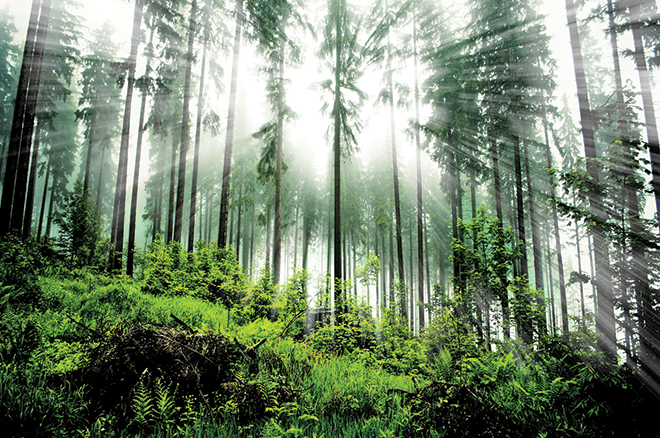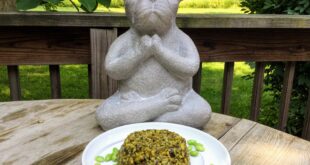
By Matthew Sleeth, MD
I love trees. I always have. One of my first memories is playing under a large dogwood whose limbs cascaded to the ground, forming a hidden world. The sun’s light filtered through thousands of white blossoms. It was a world of textures and hues: rough brown bark, smooth delicately veined white flowers, and hard red berries underlain with soft green grass. When I look back on six decades of life, some of the most beautiful moments I’ve known were in, under, and around trees. I don’t regret a moment I’ve spent with them.
This year, as we celebrate Earth Day on Monday, April 22nd, it might edify us to contemplate the nature of trees and our connection to them. Humanity has grown up in the shadow of trees. We owe them a debt that cannot be overstated.
Anthropologists name the epochs of culture after technologies in use. Thus we have the Stone, Bronze, Iron, Industrial, and Information Ages. But in truth, all of these ages take place within the larger context of trees. All ages are the age of trees. Small wonder that they are the oldest creatures on the planet. Each gets a ring on its birthday.
Our first tools were made of trees. Our food was first cooked with wood. For almost all of human history, no crossing of water took place without the aid of trees. Wooden boats were followed by planes made with wooden spars and propellers. The first nuclear powered submarine glided along the ocean’s depths with main bearings made from the tree: lignum vitae.
It wasn’t until the Age of Steam that humanity discovered what made the wind give life. The trees that made our homes, books, and everything from cradles to coffins; those same trees that gave us syrup, fruit, and nuts to put on our pancakes, were also making the oxygen used to metabolize our food and run our brains and bodies.
As a child who grew up in the woods, I remember sensing something mysterious, beyond my grasp. Was it the invisible life and oxygen that was being made by the trees around me? I do not think it was an innate awe or growing knowledge about the scientific processes taking place around me. It was both simpler—and infinitely more complicated than science. And the woods have become much more complicated of late.
Scientists have discovered that trees in a forest communicate with each other using a web of tiny tendrils dubbed “The Wood Wide Web.” Trees can count. They can warn other trees. They can share chlorophyll. All the while they go about the task of making the planet habitable. It is now known that if forests did not exist along coastlines, no rain would fall in the middle of continents: coastal forests make the clouds that travel far inland. And it is not just people who are dependent on trees. One half of the creatures that live on land are tree dependent.
From Hollywood to Cedar Rapids to the Big Apple, trees are the common physical denominator of the human experience. Yet trees seem to connect with us at a much deeper level.
In the past several decades, there has been a growing awareness that trees are good for one’s health. Studies have shown that when trees are suddenly lost in a neighborhood, rates of depression increase. Conversely, simply spending time sitting in the woods is now recognized as good medicine. The practice of forest bathing and Shinrin-yoku or Forest Therapy has become popular. These treatments are a discovery and rediscovery of what poets have known since Walden Pond was on the edge of the wilderness: trees are good for you.
Some of the health benefits of being in trees can be explained by science. If you are in a pine forest on a hot summer day and take a deep breath, the intoxicating smell you’re breathing is air cleaned of bacteria by phytoncides in the pine needles. These same compounds kill protozoa in the streams running under their boughs.
Yet for all of the scientific explanations of the woods, I’ve felt something in them that defies rational explanation. What I sense is the effect of beauty on the human soul. It is then that all of our senses demand we listen, see, taste, inhale, and hold the forest for a moment at the bottom of each breath. One catches a glimpse—or smells a fleeting scent—of wonderment.
I’ve come across this forest synesthesia in Vermont, as falling snow and clouds made the woods dark long before dusk. I’ve bumped into the wonder of walking under 300 foot tall Redwoods in the rain. I’ve lain among golden maple leaves on south-facing slopes in Wisconsin and Maine when skies above me were so clear and blue you could almost see stars at noon in October. I’ve caught the sound of it as black water flowed past the bases of loblolly pines, sweetgum, and water hickory in North America’s largest old-growth bottomland in the Congaree National Park.
Some go to the forest to find beauty, others solitude, still others health. Some go to find themselves. I’ve found all these in the woods. In my late 40s, after a life of avowed atheism, I found that thing that I’d glimpsed and heard and smelled in forests again and again. I found God. It was not a nameless god, but the God of the Bible.
I’d had the misconception that the God of the Bible didn’t care for trees. Nothing could be further from the truth. Trees are mentioned more times in the Bible than any living thing on earth other than humans. There is a tree on the first page, in the first song (Psalm One), and on the last page of the Bible.
I do not know if Abraham wore skinny jeans, but I know the exact species of tree where he met God. I do not know if Deborah was a blonde or a brunette, but I know the species of tree she held court under as she judged Israel. The Bible doesn’t say if Elijah was tall or short, but it does tell what kind of tree he retreated to when he met God.
The God of the Bible loves trees. His intention was for humanity to live among trees and care for them. The second chapter of the Bible declares that trees are the benchmark of beauty to God. This aesthetic remains unchanged throughout the Bible. The Bible even says that God’s throne in paradise faces the tree of life—and that “the leaves of this tree are for the healing of the nations.”
This Earth Day, pay close attention to the trees around you. Go to the woods. Smell and breathe in the wonder of the forest. While I cannot guarantee that you will find God there, you will certainly get a glimpse of heaven. For as the Proverbs tell us: “Her ways are pleasant ways, and all her paths are peace. She is a tree of life to those who take hold of her; those who hold her fast will be blessed.” — Proverbs 3:17-18, NIV
Matthew Sleeth, MD, is Executive Director of Blessed Earth. His newest book is Reforesting Faith: What Trees Teach Us About the Nature of God and His Love for Us (April 2019.) Visit www.BlessedEarth.org.
 Conscious Community Magazine Dedicated to Elevating Consciousness
Conscious Community Magazine Dedicated to Elevating Consciousness




